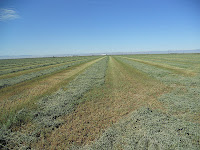 |
| Preventing sticky cotton is a top concern right now. |
Lately, more growers have been treating their cotton fields
because of rising aphid populations and an increasing number of bolls opening
up. Aphids produce honeydew. When the substance is gets on open bolls, the lint
becomes sticky and sticks to ginning and spinning equipment, causing the
threads to break. Sometimes the gin won’t even gin the sticky cotton causing a
great loss to the grower.
 |
| Growers are determining the best time to apply defoliants. |
This means we’re at a crucial time to monitor for aphids and
keep them under control. Of course, the first line of defense is natural
predators such as parasitic wasps. When the aphid numbers rise to a critical
threshold, treatment becomes the final option. Remember to check UC Integrated
Pest Management’s online resources for treatment guidelines and
materials. The guidelines will help you better discuss aphid management
strategy with your pest control advisor.
 Looking at the cotton plants, I’m seeing an average of eight
to 11 nodes above cracked boll in acala. For pima, I am finding an average of
11 to 13 nodes above cracked boll (NACB).
Looking at the cotton plants, I’m seeing an average of eight
to 11 nodes above cracked boll in acala. For pima, I am finding an average of
11 to 13 nodes above cracked boll (NACB).
Growers use the average number of nodes about cracked boll
as an aid to determine the right time to apply defoliants, taking into account
the potential loss in yield and quality from immature bolls.
Growers apply defoliants to increase the rate of leaf loss
and desiccation, which allows for timely and efficient harvesting of cotton. Determining
when to defoliate is make on a field-by-field basis. Here’s a link to the UC IPM
discussion and online calculator to figure out your NACB. Here’s another
site that talks about scheduling
defoliation.
Overall, the plants are in good shape and growers could be
in store for good yields this season.
Right now, growers are prepping for defoliation in acala.
They are using a product to speed up the ripening process to get as much fruit
to mature before defoliation. An early planting and the hot August have pushed
the season ahead of normal by a week to 10 days. I’m reminding growers to
continue monitoring for aphids as well as whiteflies. Pests are still a threat
until the plants are defoliated.
 |
| Alfalfa nears the end of the season. |
Meanwhile, alfalfa yields are starting to drop as the season
winds down. We’re pretty much out of the worm season here.
 |
| Almonds on the ground are being swept in windrows. |
On the almond front, field scout Jenna Horine reports the
harvest is in full swing. Growers are shaking nuts off the trees so they can
dry on the ground. Some are sweeping up the nuts and while others have sent
their almonds to the hullers. Jenna is seeing some debris on the ground in some
orchards. That’s a sign that some older trees didn’t handle the tree shaking
very well, causing branches and limbs to break off the tree.
Cotton Tour Reminder: There is still time to sign up for our annual Cotton Farm Tour on Friday, October 19 from 8:30 a.m. to 5 p.m. The tour begins at the Best Western Apricot Inn at Interstate 5 and West Panoche Road, about 23 miles southwest of Firebaugh. It’s a free event filled with plenty of good information. You need to register to reserve a spot in this popular event. Go to the Sustainable Cotton Project website to sign up. Tell a friend.
No comments:
Post a Comment